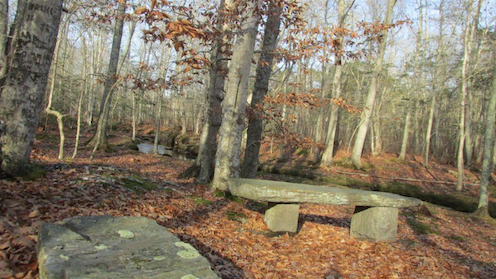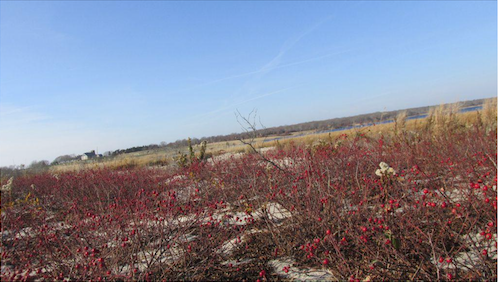Just for Fun!
Wilbour Woods and Goosewing Beach
Mystery, history, shadows and light - 2 walks in Little Compton
Photos and story by Shoshona Brown
It's December.
As we move closer to the Winter Solstice, and our various "festivals of light," many of us hope to see our local landscapes dressed in white. A dusting of snow can certainly transform a drab scene into a page from a fairy tale or holiday card, but chances are, with the weather we've been having so far (I've still got zinnias blooming in my garden!), we may have to wait a bit longer before taking out our skis or snow shoes.
Nevertheless, pre-snow winter is a great time to take a hike. Although initially we might feel sad to see the leaves fall, if we look a little more attentively, we may begin to appreciate the beauty of seeing the "bones" of the trees, and of our winter landscapes before they are blanketed in white. There is something about the low winter sunlight this time of year that induces a contemplative mood. It is perhaps the best time of year to catch a great sunset — since the sun sets so early, and the skies tend to be smog-free. And since the weather is on the cooler side, we don't feel too sorry to come inside soon, perhaps to a great meal with friends, or to curl up with a novel by the fireside.
So here are two short hikes, both in Little Compton, Rhode Island — at one you can enjoy the spare beauty of bare trees along a pristine brook; at the other, a beautiful sand beach along with trails through the dunes and views of farmland and a pond.
Wilbour Woods, on Little Compton's Swamp Road (near its juncture with Route 77, on the northeastern side of the road, marked by a wooden sign) offers history, mystery, lovely scenery and a 1.2-mile walking trail loop. After a substantial snowfall, this park is inaccessible for cars (as its drive does not get plowed), but during the rest of the year, it is freely accessible and offers parking on the grass at the end of the drive that leads into the site (another reason to go before it snows!).

The park is situated on the site of the winter camp of one of the most famous Sakonnet Indian sachems, Queen Awashonks, who was the leader of this tribe during the 1670s. The site is curiously dotted with a variety of stone items: large Stonehenge-looking upright pillars along the drive into the park, stone fireplace-grills for picnickers, stone bridges and in some places stepping stones for crossing Dundery Brook, which winds through the park, and mysterious stone slabs which now serve as picnic tables — but which one imagines might once have been used as altars during another age. There is a large stone memorializing Ashawonks, and here and there throughout the park there are wooden signs with quotations on them from figures such as Roger Williams.
This is an easy walk for hikers of all ages, and the brook, its bridges, a small waterfall and the park's unique stone features give it a charmingly mysterious feeling that make it worthwhile to go out in the cold — and perfect for an outdoor family activity during winter vacation time.
Just two and a half miles northeast of Wilbour Woods (continue on Swamp/Brownell Road, with a quick right turn at South Shore Road, left onto John Sisson Road, and then right at Long Highway) is the Nature Conservancy's Goosewing Beach Preserve. This property is just past the parking lot for South Shore Beach. In the winter you can park in this lot for free, but make sure to wear sturdy, water-resistant shoes, because in order to get to the Goosewing Preserve, you will have to cross over a small stream that flows between the two beaches.

While strolling on a beach is not much fun on a cold, windy day, if the air is still it is wonderfully therapeutic. We all suffer from insufficient sunshine in the winter, so beach-walking is great in that it gives us a double-dose of light — both from the sun itself, and from its reflection off the water. There are no trees to cast their shadows over us, and Goosewing Beach is an unusual site for the Ocean State: a fairly long sand beach without an abundance of rocks! Now some of us, like my husband, are beach walkers (when we used to live on Long Island, he loved to go to Fire Island and walk for miles and miles). And others of us prefer the surprises and variety of walking a bit back from the beach through the dunes or marsh side areas, where one discovers a diversity of plant and animal life, where the scenery changes in a more discernible way than on a flat, sandy beach. So this beach, which is so pristine and uncrowded in the wintertime, is perfect for my family. My husband takes his long beach walk, and my son and I take the trails up behind the beach, with ocean beach on one side of us, and the inland waters of Quicksand Pond on the other side of us.

According to one article I found online, Quicksand Pond "has been called one of the most significant migratory waterfowl concentration sites of New England." All around the site you will see signs warning you not to disturb the nesting areas of the endangered piping plovers, but in the winter you do not need to worry about this (and therefore, you can also bring Fido along, which you should NOT do in the summertime). At this time of year, you will mostly see swans, Canada geese, and various ducks on the pond. One thing I love about walking on these dune trails is swath of beach-rose brambles, bearing their red rosehips. When returning towards the parking lot (heading west), you also have a bucolic view of the adjacent farm with its fields and stone walls.
As the beach here faces south, it is an ideal place to enjoy either sunrise or sunset. If you are a birder, don't forget your binoculars and camera. But at this time of year, it is great to just come in the middle of one of our short winter days to soak up a double-dose of sunshine, to revel in the sparkle of sunlight off the waves, and in the opportunity for solitude on the beach. Who knows? Winter may even begin to be your favorite New England season!
<Back
Social